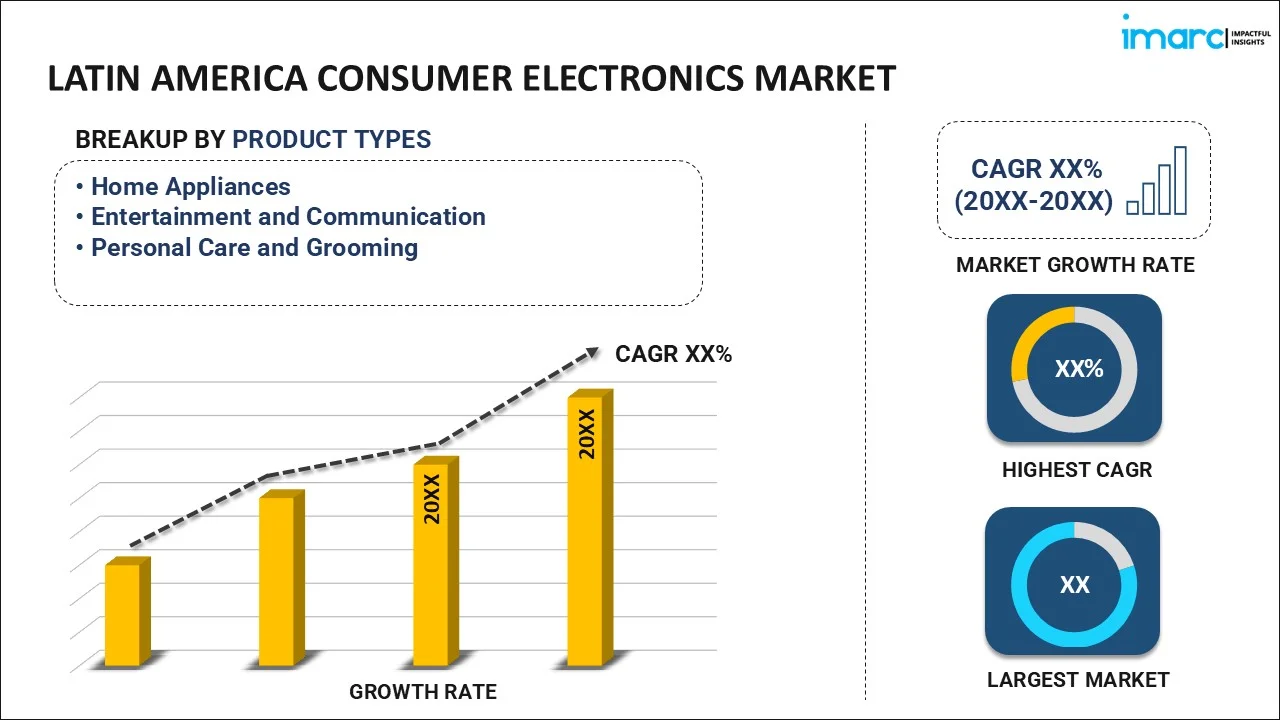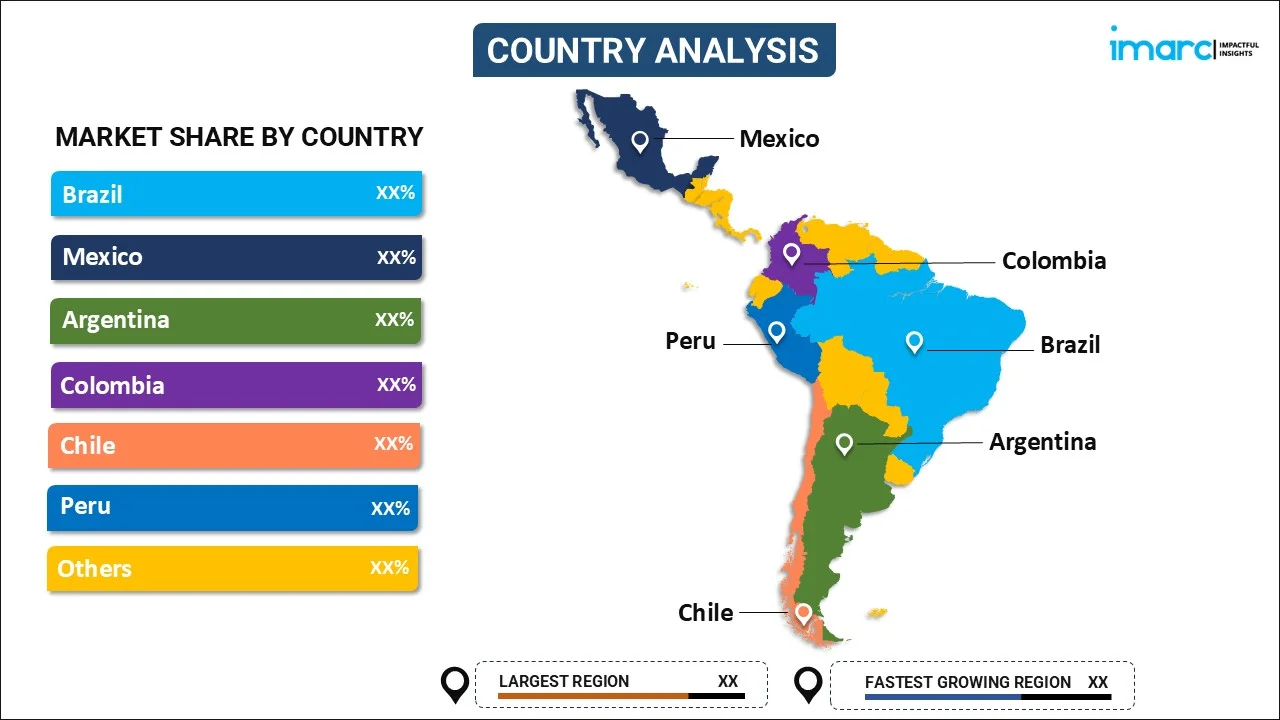
Latin America Consumer Electronics Market Size, Share, Trends and Forecast by Product Type, Category, End-Use, Distribution Channel, and Country, 2025-2033
Latin America Consumer Electronics Market Overview:
The Latin America consumer electronics market size reached USD 78.44 Billion in 2024. Looking forward, IMARC Group expects the market to reach USD 145.43 Billion by 2033, exhibiting a growth rate (CAGR) of 6.80% during 2025-2033. The Latin America consumer electronics market share is increasing due to e-commerce growth, sustainability trends, and 5G adoption. Increased online shopping, eco-conscious user preferences, and improved connectivity are also driving the demand for smart devices, energy-efficient products, and IoT-enabled solutions, shaping the region’s digital transformation and technology landscape.
|
Report Attribute
|
Key Statistics
|
|---|---|
|
Base Year
|
2024 |
|
Forecast Years
|
2025-2033
|
|
Historical Years
|
2019-2024
|
| Market Size in 2024 | USD 78.44 Billion |
| Market Forecast in 2033 | USD 145.43 Billion |
| Market Growth Rate (2025-2033) | 6.80% |
Latin America Consumer Electronics Market Trends:
Impact of 5G Rollout and Enhanced Connectivity
The growth of 5G networks throughout Latin America is revolutionizing the consumer electronics sector by facilitating quicker internet speeds, reduced latency, and enhanced device connectivity. Nations such as Brazil, Mexico, Chile, and Argentina are putting money into 5G infrastructure, increasing the need for compatible smartphones, tablets, and smart home gadgets. People are transitioning to devices that support 5G to enjoy better streaming, quicker downloads, and improved gaming performance. The rollout is also speeding up the use of IoT devices, such as intelligent security cameras, linked appliances, and industrial automation equipment. Companies are utilizing 5G to enhance remote work options, driving the need for high-end laptops, cloud storage, and collaborative tools. Telecom providers are still broadening their coverage, and the availability of fast internet is anticipated to enhance electronics usage in both urban and rural regions. According to GSMA reports published in 2023 , by March 2023, eight nations in Latin America had launched commercial 5G services. The count of 5G connections was anticipated to grow steadily in the coming years, with a notable surge expected in the latter part of the decade as new 5G markets developed and current networks expanded to encompass more regions. Consequently, the uptake of 5G was anticipated to surpass that of 2G in 2024, 3G in 2026, and 4G in 2029. By 2030, it was expected that 5G would make up almost 60% of all mobile connections in Latin America.
Sustainability and the Shift Toward Eco-Friendly Electronics
Environmental consciousness is influencing purchasing decisions, with people in Latin American showing an increased preference for eco-friendly electronics. Companies are reacting by creating energy-saving products, utilizing recycled materials, and establishing take-back initiatives for electronic waste. Government policies regarding e-waste disposal and carbon output are additionally promoting sustainable manufacturing methods. Firms are launching modular smartphones and repairable laptops to lengthen product lifespan, thus decreasing electronic waste. Home appliances that are energy-efficient and powered by solar energy are becoming increasingly popular, particularly in nations where electricity prices are high. Merchants are increasingly implementing environmentally friendly practices, including trade-in initiatives and discounts on green products. As recognition of climate change increases, the demand for eco-friendly electronics is rising, prompting producers to create biodegradable packaging, use sustainable materials, and adopt production methods that reduce carbon emissions. In 2024 , Samsung broadened its recycling and waste collection initiative for consumer electronics to include Paraguay, Bolivia, and the Dominican Republic, enhancing its reach to 13 Latin American nations. The campaign aimed to gather a minimum of 14,183 tons of e-waste, underscoring Samsung's dedication to responsible electronics disposal and sustainability.
Expansion of E-Commerce and Digital Platforms
The growing number of e-commerce channels in Latin America is transforming individual buying behavior, encouraging more people to online shopping. Countries like Brazil, Mexico, and Argentina have seen fast digital growth, with many choosing online shopping for its convenience and wider product availability. For instance, according to the article released by The International Trade Administration in 2023 , Brazil, the largest economy in Latin America, witnessed a 14.3% increase in e-commerce and was projected to surpass US$200 billion by 2026. The pandemic accelerated this trend, reinforcing user reliance on digital channels. Additionally, retailers and brands have responded by enhancing their online presence, offering competitive pricing, and providing customer-friendly services such as easy returns and fast delivery. This expansion of e-commerce has bridged the gap between individuals and technology, stimulating growth and providing a boost to the overall consumer electronics market.
Latin America Consumer Electronics Market Segmentation:
IMARC Group provides an analysis of the key trends in each segment of the market, along with forecasts at the country level for 2025-2033. Our report has categorized the market based on product type, category, end-use, and distribution channel.
Product Type Insights:

- Home Appliances
- Large Electronics Appliances
- Refrigerators
- Air Conditioners
- Washing Machines
- Air Purifiers
- Others
- Small Electronics Appliances
- Microwave Ovens
- Food Processors
- Electric Fans
- Vacuum Cleaners
- Others
- Large Electronics Appliances
- Entertainment and Communication
- Televisions
- Mobiles and Smartphones
- Laptops and Computers
- Audio and Video Players
- Cameras
- Speakers
- Video Games
- Others
- Personal Care and Grooming
- Wearables
- Smartwatches
- Headphones
- Earphones and Earbuds
- Others
- Hair Care Devices
- Hair Straightener
- Hair Curler
- Hair Dryer
- Others
- Beauty Devices
- Face/Skin Care Devices
- Hair Removal Devices
- Nail Care Devices
- Others
- Others
- Wearables
The report has provided a detailed breakup and analysis of the market based on the product type. This includes home appliances [large electronics appliances {refrigerators, air conditioners, washing machines, air purifiers, and others}, small electronics appliances {microwave ovens, food processors, electric fans, vacuum cleaners, and others}, entertainment and communication {televisions, mobiles and smartphones, laptops and computers, audio and video players, cameras, speakers, video games, and others}, personal care and grooming {wearables (smartwatches, headphones, earphones and earbuds, and others), hair care devices (hair straightener, hair curler, hair dryer, and others), beauty devices (face/skin care devices, hair removal devices, nail care devices, and others), and others}]
Category Insights:
- Smart
- Conventional
A detailed breakup and analysis of the market based on the category have also been provided in the report. This includes smart and conventional.
End-Use Insights:
- Residential
- Commercial
- Hotels and Restaurants
- Cafes
- Hospitals
- Corporate Offices
- Others
The report has provided a detailed breakup and analysis of the market based on the end-use. This includes residential and commercial (hotels and restaurants, cafes, hospitals, corporate offices, and others).
Distribution Channel Insights:
- B2B
- B2C
- Online
- Company-owned Websites
- E-commerce Websites
- Offline
- Supermarkets/Hypermarkets
- Specialty Stores
- Others
A detailed breakup and analysis of the market based on the distribution channel have also been provided in the report. This includes B2B and B2C [Online {Company-owned Websites and E-commerce Websites} and Offline {Supermarkets/Hypermarkets, Specialty Stores, and Others}].
Country Insights:

- Brazil
- Mexico
- Argentina
- Colombia
- Chile
- Peru
- Others
The report has also provided a comprehensive analysis of all the major regional markets, which include Brazil, Mexico, Argentina, Colombia, Chile, Peru, and others.
Competitive Landscape:
The market research report has also provided a comprehensive analysis of the competitive landscape. Competitive analysis such as market structure, key player positioning, top winning strategies, competitive dashboard, and company evaluation quadrant has been covered in the report. Also, detailed profiles of all major companies have been provided.
Latin America Consumer Electronics Market News:
- In May 2024, The Multi Group, formerly known as Multilaser, partnered with China’s Oppo to produce and distribute smartphones in Brazil. Magalu, as the exclusive reseller, will manage sales. Oppo plans to grow its presence in Brazil with the launch of the A40 smartphone.
- In February 2024, Samsung's popular Galaxy S24 flagship series became available in the Mexican consumer electronics market. Customers can purchase these advanced smartphones at Samsung stores nationwide, enhancing access to cutting-edge technology and strengthening Samsung's foothold in the region.
Latin America Consumer Electronics Market Report Coverage:
| Report Features | Details |
|---|---|
| Base Year of the Analysis | 2024 |
| Historical Period | 2019-2024 |
| Forecast Period | 2025-2033 |
| Units | Billion USD |
| Scope of the Report |
Exploration of Historical Trends and Market Outlook, Industry Catalysts and Challenges, Segment-Wise Historical and Future Market Assessment:
|
| Product Types Covered |
|
| Categories Covered | Smart, Conventional |
| End-Uses Covered |
|
| Distribution Channels Covered |
|
| Countries Covered | Brazil, Mexico, Argentina, Colombia, Chile, Peru, Others |
| Customization Scope | 10% Free Customization |
| Post-Sale Analyst Support | 10-12 Weeks |
| Delivery Format | PDF and Excel through Email (We can also provide the editable version of the report in PPT/Word format on special request) |
Key Questions Answered in This Report:
- How has the Latin America consumer electronics market performed so far and how will it perform in the coming years?
- What is the breakup of the Latin America consumer electronics market on the basis of product type?
- What is the breakup of the Latin America consumer electronics market on the basis of category?
- What is the breakup of the Latin America consumer electronics market on the basis of end use?
- What is the breakup of the Latin America consumer electronics market on the basis of distribution channels?
- What is the breakup of the Latin America consumer electronics market on the basis of country?
- What are the various stages in the value chain of the Latin America consumer electronics market?
- What are the key driving factors and challenges in the Latin America consumer electronics market?
- What is the structure of the Latin America consumer electronics market and who are the key players?
- What is the degree of competition in the Latin America consumer electronics market?
Key Benefits for Stakeholders:
- IMARC’s industry report offers a comprehensive quantitative analysis of various market segments, historical and current market trends, market forecasts, and dynamics of the Latin America consumer electronics market from 2019-2033.
- The research report provides the latest information on the market drivers, challenges, and opportunities in the Latin America consumer electronics market.
- Porter's five forces analysis assist stakeholders in assessing the impact of new entrants, competitive rivalry, supplier power, buyer power, and the threat of substitution. It helps stakeholders to analyze the level of competition within the Latin America consumer electronics industry and its attractiveness.
- Competitive landscape allows stakeholders to understand their competitive environment and provides an insight into the current positions of key players in the market.
Need more help?
- Speak to our experienced analysts for insights on the current market scenarios.
- Include additional segments and countries to customize the report as per your requirement.
- Gain an unparalleled competitive advantage in your domain by understanding how to utilize the report and positively impacting your operations and revenue.
- For further assistance, please connect with our analysts.
 Request Customization
Request Customization
 Speak to an Analyst
Speak to an Analyst
 Request Brochure
Request Brochure
 Inquire Before Buying
Inquire Before Buying




.webp)




.webp)












